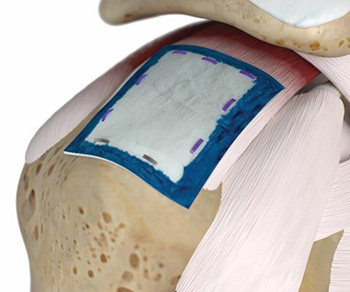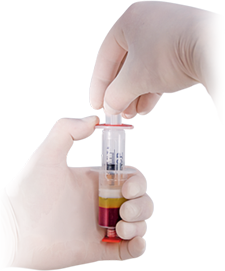Latest Technologies
Orthopaedics is a rapidly developing field of Medicine. As a consequence, I’ve started using a number of new treatments and technologies in order to help my patients. Here is a brief summary:
Base of thumb carpo-metacarpal (CMC) joint replacement
Many people develop arthritis in the joint at the base of the thumb between the base of the metacarpal and the trapezium bone. This joint is also known as the CMC-joint (carpo-metacarpal joint). There are different ways of dealing with the symptoms from CMC-joint arthritis ranging from non-operative treatment so surgery. Joint replacement surgery for arthritis at the base of the thumb has gained in popularity in recent years thanks to a new generation of dual mobility implants. Suitable patients can benefit from quicker recovery and better functional outcomes compared to traditional surgical techniques like trapeziectomy (excision of the trapezium bone).
For more information please click here
Regeneten Bioinductive Implant:
This is one of my new favourites and I'm genuinely excited to be able to offer this to my patients!
Inside the shoulder is a layer of tendons called the rotator cuff. Unfortunately, rotator cuff tendons suffer from age and often start tearing as a result of years and years of use and gradual wear & tear. Many patients benefit from keyhole surgery to repair the torn rotator cuff. This is then followed by a lengthy rehab process. While the surgical techniques to repair the rotator cuff have developed and improved rapidly in recent years, there are still problems that so far have been difficult to address. The Regeneten implant is a novel way of aiding the healing of rotator cuff tendons. While similar implants (or patches, as they are also commonly referred to) have been in use for a few years, the Regeneten implant has taken the concept a big step further by making patches quick and simple to use. Up to now it would have taken an hour or more to attach a patch to the rotator cuff, with the Regeneten implant it only takes 15-20 minutes thanks to using an innovative system of bioabsorbable staples. There are 2 different ways in which the Regeneten implant can be used: Re-inforcing a repaired rotator cuff tendon or re-inforcing a partial thickness tear in the rotator cuff. Let me explain this in more detail:
- Re-inforcing a repaired rotator cuff tendon: Repairing rotator cuff tendons is carried out as keyhole surgery. The tendon is mobilised, freshened up and then re-attached to it's bony insertion using bone anchors and sutures. It then takes many months for the tendon to heal. There is a risk of the repair failing and there many reasons why this may happen: as a result of an injury during the rehab, because the quality of the tendon was poor to start with or because the healing response wasn't good enough. Augmenting the repaired tendon with the Regeneten implant makes the repair stronger. The implant will eventually get integrated into the tendon, making the tendon thicker and stronger, thereby allowing the tendon to transmit forces more efficiently and reducing the risk of the repair failing.
- Re-inforcing a partial thickness tear of the rotator cuff. Partial thickness tears are a halfway house: there is some tearing, but the tendon is still attached to the bone. Partial thickness tears don't heal by themselves. A repair doesn't always make sense and there is always a risk that the tear progresses with time and eventually becomes a full-thickness tear. Augmenting and re-inforcing the partially torn tendon with the Regeneten implant is a comparably simple procedure carried out as keyhole surgery. In the months following surgery the implant gets incorporated into the tendon and makes it stronger. What's even more impressive is the research showing how the partial thickness tear often heals with time. Conventional augmentations techniques are difficult and time-consuming, often requiring more than one hour to carry out while the Regeneten implant can be fixed to the tendon in 15-20 minutes using a simple and reproducible technique.
Being able to use the Regeneten implant has been a major innovation for me, helping my patients with rotator cuff tears getting better outcomes.
There is more information about the Regeneten implant on the manufacturer's website: www.rediscoveryourgo.com/shoulder-technology/regeneten-bioinductive-implant/

PRP Injection Treatment:
Platelet-Rich-Plasma is a fairly new and innovative treatment. PRP is a concentrated preparation of platelets and their associated growth factors that is prepared from a small blood sample. PRP is thought to promote tissue healing and regeneration by delivering those growth factors in a high concentration to the treated area. Typical indications include soft tissue conditions like tennis and golfers elbow as well as shoulder problems like impingement and rotator cuff tendinopathy. PRP can also be used for the treatment of early arthritis. Taking the blood sample and carrying out the injection can be done during a single outpatient appointment.
 ACP Therapy - For Mild to Moderate Osteoarthritis and Certain Sports Injuries ACP Therapy - For Mild to Moderate Osteoarthritis and Certain Sports Injuries

nSTRIDE APS:
nSTRIDE autologous protein solution is a groundbreaking new treatment for patients with arthritis. The treatment is somewhat similar to PRP treatment: a blood sample is obtained and centrifuged, resulting in a fluid sample containing a high concentration of growth factors, anti-inflammatory cytokines and white blood cells. The main difference between PRP and nSTRIDE APS is the high concentration of white blood cells in nSTRIDE. The early scientific results are promising. Particularly patients with arthritis who would otherwise require joint replacement surgery can benefit from an injection with nSTRIDE APS.
 Click here to know more Click here to know more
Endoscopic Carpal Tunnel Release:
This is a minimally invasive way of carrying out carpal tunnel release surgery. While traditional open surgery requires an incision in the palm, endoscopic surgery offers the advantage of a much smaller incision in a more advantageous location in the forearm. This results in a quicker recovery with faster return to function and to work.
More information can be found here: Endoscopic Carpal Tunnel Release
And here: ECTR PATIENT RevA
Treatment of Irreparable Rotator Cuff Tears
The rotator cuff is an important layer of tendons deep inside the shoulder joint. The tendons grasp and surround the head of the arm bone. The rotator cuff is all important in initiating and coordinating all shoulder movements.
Click here to know more
Keyhole Surgery for the Treatment of Dislocating Shoulder
Open surgery used to be the gold standard treatment for patients with shoulder instability in the past. For many years however, keyhole surgery (also known as arthroscopic surgery) has been used successfully to help patients with shoulder instability. Minimally invasive surgery uses just tiny stab incisions. This causes less tissue damage than open surgery though a large incision and allows patients to recover much quicker.
Click here to know more
Tennis and Golfer's Elbow
Both tennis elbow (also known as lateral epicondylitis) and golfers' elbow (medial epicondylitis) are conditions that cause pain in the elbow - either on the outer side (tennis elbow), or on the inner side (golfers' elbow). Both are overuse conditions - the daily use causes more damage to the tendon than the body can repair. The result is microtearing in the tendon. In tennis elbow this affects the tendons that extend the wrist and fingers, particularly the so-called ECRB tendon. These tendons are attached to the prominent bone on the outer side of the elbow. The ECRB tendon is located in a deeper layer, seems to get less blood supply and is more prone to mechanical irritation when it moves over the bone. Golfers elbow affects the tendons responsible for bending the wrist and rotating the forearm. These tendons originate from the prominent bone on the inner side of the elbow. In the past it was felt that tis is an inflammatory condition, but the changes seen in the diseased tendon under the microscope point towards overuse and repetitive strain as the main problem.
Click here to know more
You will need the Adobe Reader to view and print the above document.
|



